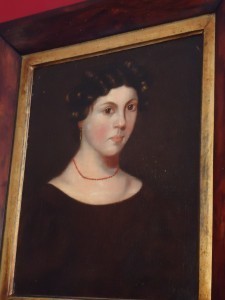Instant Ancestor
Lea Wait, here. I don’t remember a time I didn’t know about the quest for “instant ancestors.”
Portraits of my real ancestors, on my mother’s side, hung In the home where I grew up: four large portraits of two couples from Edinburgh, painted in the middle of the nineteenth century. I remember my grandmother pointing at one of the women and telling me I’d inherited her blue eyes. Perhaps unlikely, but a connection to the past.
Those people on the walls were part of my history. I didn’t think much about them, to be honest.
But as I grew up I realized that for some people, portraits or, to a lesser extent, photographs, of ancestors were particularly important, perhaps to establish the importance of their forebears. (Poor families didn’t have their portraits painted.) In fact, for a percentage of those people, portraits of ancestors are so important, that, if they don’t inherit any, they buy them. 
Since I grew up in the antique business, I remember dealers who specialized in paintings joking about their customers looking for to fill their living room or dining room walls with portraits. “Instant ancestors,” the dealers called them — out of hearing of the customers, of course.
There have always been families who were either tired of their family portraits, or had no space for them, or felt they didn’t match a modern décor. So portraits do come on the market.
Most people were looking for attractive white people, fashionably dressed, and painted by, if not a “name” painter, than at least a competent one. (Folk art portraits often are more valuable as art, but not always saleable as relatives.)
From the point of view of the buyers, it didn’t matter who the people were or the artist was. And unsigned paintings, without provenance (the history of the painting and perhaps the subject) are less valuable than those of specific people. So it all worked out.
I never thought much about it.
And then, after my mother died, the portraits that were in her house went to one of my sisters. I had agreed to that. And with a husband who is an artist, and an antique print business, we had plenty of choices of what to hang on our walls.
Then, about ten years ago my husband and I were doing the fall Rhinebeck Antiques Show (the show I fictionalize in Shadows at the Fair). I’d done the show for almost thirty years. I loved the show, and the dealers. But the buyers were changing, and the dealers were retiring. Instead of being one of our best shows of the year, we were barely making expenses. As we sat, hoping for sales, we decided we probably not do the show again.
It was a sad moment.
The dealer across the aisle from us, an older woman from Connecticut, was also saying it might be her last Rhinebeck. She had cancer. As the weekend went by, we talked. And from where we sat in our booth we looked directly at a portrait she’d hung in her booth.
The portrait was of a young woman, not perfectly painted, but distinctive. All the dealer knew was that she’d lived in Connecticut, probably in the first half of the 19th century.
Saturday night I checked the price tag. It was fair, but oo high for us, who were worried about paying our booth rent. I pointed the portrait out to my husband and, to my surprise, he told me he’d been fascinated by it all weekend, too.
Sunday afternoon before packing out I admired it once more. And the dealer said, “I’ll give you a good price. I need to move some inventory. And you don’t have to pay me everything now.”
A quick consultation with my husband and the mysterious woman ended up in our van, headed for Maine. It was an impulse buy. We paid for her over the next few months.
And now she hangs over our dining room fireplace. People often ask, “Is she a relative?”
And we answer, “No. She’s a friend.”
Someday I may put her in a book. But, in addition to the mystery of who she is, she brings with her memories of all my years at the Rhinebeck Antique Show. And, at least for our lifetimes, she’s found a new family.
Lea Wait's Blog
- Lea Wait's profile
- 509 followers



